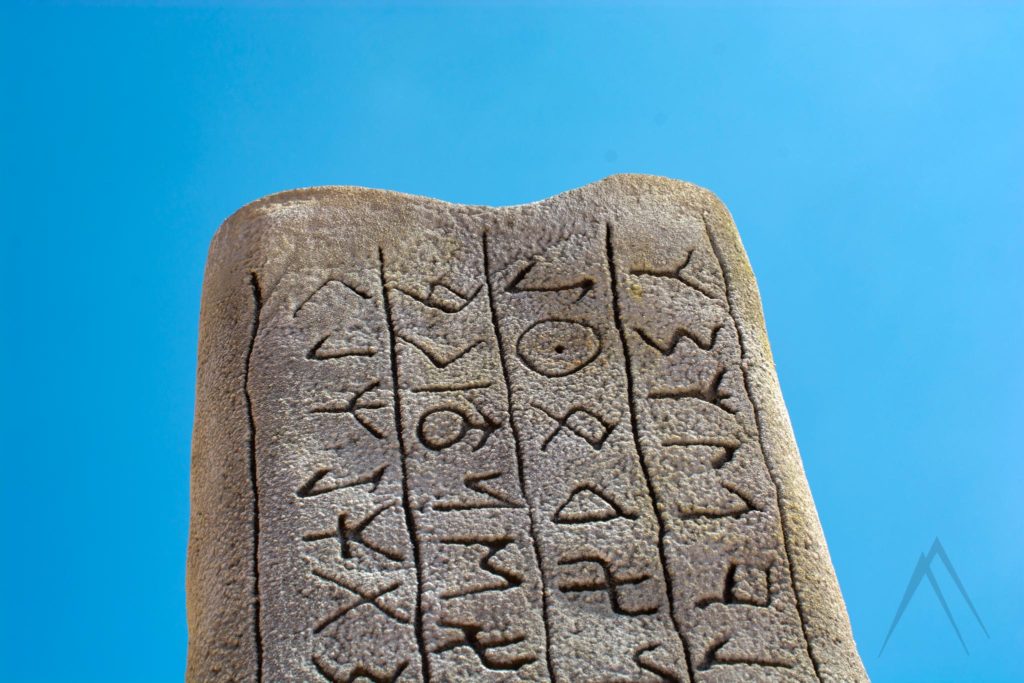TENGRISM
Tengrism - ancient religion practiced in Central Asia
Over the centuries, from ancient times, a remarkable range of religions and cultures have affected the people of the huge territory comprising of today’s Kazakhstan. Among these influences there were at least Buddhism, Zoroastrianism, Shamanism, Judaism, Nestorianism, Taoism, Christianity and eventually Islam. But before any of the religions mentioned, there was the Tengrism. The spur for Tengrism was the Steppe itself – the vast reach of land and the fathomless bowl of sky. This enormity and emptiness brought into being one of the most significant systems of belief on Earth, a great combination of monotheism and polytheism that is identified as Tengrism. You can also see sights related to Tengrism during our Kazakhstan Tours.
The concept of Tengrism – the religion named after the supreme deity Tengri (‘The Sky’) grew out of a primal heathen pantheism into a coherent and lively faith in the ‘unity of all things’ that continued to live alongside Islam and Christianity up to the fifteenth century and may be said to be present in the souls of Kazakhstan and Mongolia even today. Some traces of Tengrism can also be found in the Kyrgyz pilgrimage sites. Tengri based beliefs can still be widely seen in all Central Asian countries with the tradition of worshipping natural wonders but nowadays they are mostly combined with Muslim beliefs and the pilgrimage sites have nowadays mostly legends somehow associated with Islam, even though they have been worshipped already for long before Islam ever came to Central Asia.
The word ‘Tengri’ was obtained from the ancient runic inscriptions found in Kazakhstan and interpreted by the Danish scholar, Vilhelm Thomsen, in 1893. The Turkic origin of this word is no longer in doubt. The idea of Tengri in all its beauty appeared at the time of the Turks in the most ancient sign and eventually took form as a pagan country-dwellers – religion at the time of the Huns’ early state (third-century ВС). The cult of the Substance (or ‘being’) of Heavens (Kuk Tengri) – according to the investigator of Tengrism, Kutluay Erdogan I as well as the cult of the Substance (‘being’) of Earth (Jir Tenre), was characteristic of the Turkic tribes inhabiting all regions of ancient Central Asia.
For these nomads, roaming the Steppe, moving their herds from one pasture to the next, the heavens, the mountains, the hills, the rivers, the trees and the creatures were all holy manifestations of a single Whole, worthy of adoration. Emerging from contacts with Indian, Tibetan and Chinese cultures, the Tengrist cult was perceived at its root by the ideas of Buddhism with its characteristic hierarchy of spirits, often represented on the ground by animals.
These spirits were loci of either evil or good; to avoid the disfavor of the forces of evil, men were to win the favor of the forces of good. Genghis Khan and his followers are also known to be strong followers of the Tengri. The fall of Tengrism started when the Mongol state expanded and the rulers of different areas were converted to different religions.

Tengrism Rituals
Various sacrificial rituals were performed by shamans at elaborate ceremonies, seeking salvation from the spirits of sickness and poverty, and admission in the afterlife to one of seventeen levels of the Tengri’s Heavens. These shamans (or kams) clearly described their journey to the Heavens during the rituals. After sprinkling the sacred hearth with kumys (fermented horse’s milk), the shaman would fall to the ground in ecstatic shaking and would start narrating – often rhythmically, to collective chanting – something allegorical, to be interpreted by the gathering and seized upon as revelation.
The rituals customarily were executed at the summits of hills or in the mountains, or on river banks, or amid sacred beech or Juniper groves. The mountains played a very special part in the formulation of Tengrism. Juniper branches are also often burned during rituals, in the similar manner as is common for zoroastrianism. Spilling of fermented horse milk (Kymyz) is also a live tradition still practiced.


Drawing upon numerous sources, the twentieth-century Turkish scholar Abdulkadir Bean has highlighted the role of the stone cairns (uba), such as still survive in the Altai mountains and the southern Urals. They were built by the ancients as votive structures for the spirits of the mountains. The highest peak of the Tien Shan inevitably took the name of the deity, Mount Tengri.
Rising against a background of the endless spaces of the Steppe, the soaring and virtually unsaleable mountains naturally presented themselves as a physical bridge between Earth and Heavens. Words whose root implied ‘height’ soon became synonymous with the “divine”. This led to the ultimate narrowing of the idea of “height” to the concept of the One god Tengri – proclamation, in effect, of monotheism.
In the sixth century, Tengrism suffered an assault by Christianity; in the seventh, it survived the endeavor of Judaism to penetrate the territories of Tengrist adherence. By the birth of Islam in the seventh century and its militant sweep across Asia in the ensuing generations, Tengrism was subtly enhanced and refined with all the attributes of a millennium-old religion: temples, priests, prophets, a verbal tradition and written canons.
Yet, for several centuries, it was to prove an effective competitor with other, more codified and dogmatic religions. Only in the fifteenth century was it overwhelmed by Islam. It is still nevertheless evident in prayer in certain mosques and among certain communities by the transposition of Allah as the name of God with Tengri, and in the prevailing attitude among Kazakhs of reverence for the singleness of creation.
Tengri Gods
Tengrism is centered on the worship of the Tengri (gods) and the sky deity Tengri (Heaven, God of Heaven). This is similar to Taoism and Tengri is often linked to the Chinese Tian. Kök (Gök) Tengri (Blue Sky) is the sky deity and often considered as the highest god. While Gök Tengri always remains abstract, never depicted in anthropomorphic or zoomorphic forms, other deities are often personified.
The total number of deities believed to exist varies from population to population. Deities may be related to natural aspects of the world, such as earth, water, fire, the sun, the moon, stars, air, clouds, wind, storms, thunder and lightning, and rain and rainbows. Animals were thought to be totemistic symbols for specific gods, like the sheep being associated with fire, cows with water, horses with wind, and camels with earth.
Other religions in Central Asia
All Central Asian countries are secular states but a vast majority of Central Asians are nowadays Sunni Muslims and in many regions the portion of openly Muslim people is increasing after the Soviet period when religions were officially banned. The Central Asian cultures seem to be slowly turning towards a more strict Muslim culture where women are required a scarf outside the house and each. Even the smallest community, often funded by the oil rich Middle East countries, has their own mosque. It is also harder and harder to find for example pork meat in Central Asia. Another major part of the Central Asian population are the members of the Russian Orthodox Church. On the other hand, alcohol is widely available and often openly consumed in restaurants and bars. The Pamiri people follow the teachings of Shiite Aga Khan.
In the past, Central Asia was dominated by Zoroastrianism, also known as fire worshipping. It spread to to Central Asia from Persia. Buddhism was introduced to Central Asia over 2 200 years ago. It thrived along the Silk Road and influenced the region’s art, culture, and philosophy. There are also several sights in Central Asia where we can still see remains of Buddhist temples and other sites of worship. Buddhism flourished in parts of Central Asia until the 11th century, particularly under the patronage of the Uighur Turks. However, with the rise of Islam (beginning in the 7th century CE) started to weaken the Buddhism in the region and the region was fully dominated by Islam by the 16th Century.
There are several Sufi sites in Central Asia that the locals often do not wish to refer to as Sufi sites but plainly as Islamic sites. Sufism represents the inner, mystical dimension of Islam. It emphasizes spiritual experiences and direct communion with God.
Central Asia also witnessed the coexistence of Manichaeism, Nestorian Christianity, East Syriac Christianity and other belief systems.
Sights where Tengrism can be seen
Page updated 13.1.2025